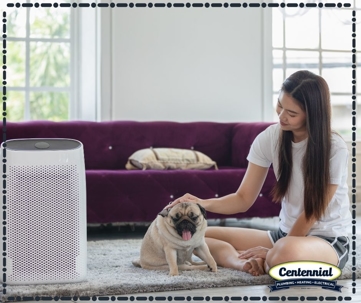Improving Indoor Air Quality
Breathing clean air inside your home should be the norm, right? Unfortunately, that’s not the case for a lot of people, especially those with homes that don’t have updated air filtration systems.
The quality of the air you breathe inside your home is even more essential these days, and here’s why.
How Air Quality Affects Health
With most people spending the majority of their days indoors, having quality air is important for your health, productivity, and overall well-being.
In some cases, poor air quality can lead to long-term health effects. Pollutants, gases, and even dangerous chemicals can seep in through the air and cause ailments like headaches, trigger indoor allergies, or fatigue. Even viruses can be passed through the air if there isn’t a proper filtration system in place.
Symptoms linked to poor air quality include:
- Sinus congestion
- Dizziness
- Nausea
- Coughing and sneezing
- Shortness of breath
- Dryness of skin, throat, eyes, or mouth
The signs of health issues related to indoor air quality can take time to recognize, but if you feel your filtration system is outdated, you should contact an experienced HVAC technician.
Identifying Poor Air Quality
Signs that your indoor air quality isn’t up to par aren’t always obvious at first, even if you begin to experience the symptoms listed above. Knowing exactly what to look for can be challenging, but a knowledgeable HVAC technician would know what to look for and where to search to investigate possible air pollutants indoors.
In fact, there can be up to 900 toxins that pollute the air inside your home. Certain activities, such as smoking cigarettes indoors, majorly reduce the quality of your air.
Common Indoor Air Pollutants
One of the most “popular” indoor pollutants is radon. This is a dangerous pollutant that can make symptoms of asthma worse. Additionally, it increases the risk of children catching ear infections and is the second leading cause of lung cancer. Radon can enter your home through cracks and unsealed openings.
Another thing to consider: gases that are known as “combustion pollutants,” including carbon monoxide, come from burning materials or common fuel-burning appliances that aren’t vented correctly, like wood stoves, water heaters, fireplaces, or dryers.
You can avoid breathing in carbon monoxide and other dangerous gases with a carbon monoxide or smoke detector, and a technician can ensure it’s installed correctly and placed in the best locations. Additionally, a technician can measure the quality and safety standard of your air and compare it to your local safety and health standards.
Other Issues Related to Poor IAQ
Unfortunately, poor indoor air quality doesn’t only affect your breathing. It can cause structural problems inside your home or building. Too much moisture isn’t just bad for humans, but it can cause lasting damage if it’s not addressed properly — such as:
- Peeling paint
- Higher-than-normal energy bills
- Dampness in attics, basements, or crawl spaces
- Rotting structure
- Mold growth
- Damage to electrical appliances
Improve IAQ With Help from an Expert
One of the leading ways to combat poor indoor air quality is to get an assessment of the air quality in your home from a qualified HVAC technician. We offer services to assess indoor air quality and inspect your current ventilation system and ductwork.
During the inspection, we will discuss solutions that fit your situation and improve your air quality such as installing an electric air cleaner, humidity control, UV lights, and more.
If you believe your indoor air quality is poor and you have questions or concerns about your ventilation system, Centennial Plumbing, Heating & Electrical has the necessary tools to test your system. We can also install and replace outdated ventilation systems.
Give us a call today at (306) 500-7392 to speak with one of our expert HVAC technicians!

